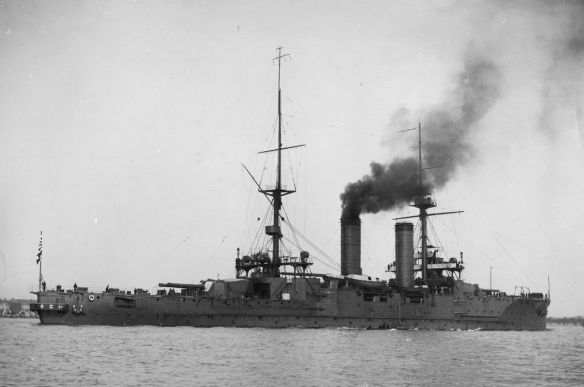Ikoma at Portsmouth 1908–09
Their construction, although a clever concept, was not a new one because the Italian Navy had been building on this theme – battleship armament on a cruiser hull – for some time. This was fine in theory, but because the type was expected to face heavily protected battleships they were in great danger, owing to their light scale of protection, as the approaching world conflict was about to reveal. Aesthetically, they were nice-looking vessels, and not unlike Kashima from a distance.
Tsukuba at Portsmouth 1908
Tsukuba was reduced to a training ship in 1916, but in February 1917 she was victim of an internal explosion while lying at anchor in Yokosuka Harbour. Looking at warships in general during this period, the only nations not to suffer such an occurrence were France, Germany and the USA. By contrast, Japan, Russia, Great Britain and Italy all suffered in this manner.
Ikoma’s quarterdeck 1908–09
On completion, Tsukuba and Ikoma were classed as large armoured cruisers, but when the term battlecruiser came into use (1912–13) they were re-classed as such. A comparison with contemporary battlecruisers will show that they had only half the main armament (4 x 12in as opposed to 8), but they were excellent ships for their displacement and could in fact be classed as small battlecruisers. Laid down during the Russo-Japanese War, their construction benefited from the lessons of that conflict and they were the first Japanese warships to have improvements worked into them as a result of battle experience.
Ikoma in Sasebo Bay 1918
Ikoma anchored in Sasebo Bay after the end of hostilities in 1918. As Ikoma and her sister were not completed until 1907–08 and owing to the dramatic advances in warship technology, they were more or less outdated and outclassed by that time. Comparison with the Royal Navy’s battlecruisers placed them as second-rate vessels and certainly not fit for the front line of a battle fleet defence. Ikoma played her part during the First World War by cruising Pacific waters and protecting British shipping from any potential German threat.
Specifications
Displacement: 13,750 tons normal load
Dimensions: Length: 450ft oa; Beam: 75ft; Draught: 26ft mean
Armament: 4 x 12in 45cal; 12 x 6in 45cal; 12 x 4.7in; 2 x 14pdr; 3 x 3pdr; TT: 3 x 18in
Armour: Main belt: 7in–4in; Barbettes: 7in; Turrets: 7in (faces); Casemates: 5in; Decks: 2in (armoured); Conning tower: 8in–6in
Machinery: Two sets three-cylinder, reciprocating engines driving two screws, twenty Miyabara boilers
Designed SHP: 20,500 for 20.5 knots
Fuel: 600 tons coal min, 1,900 tons max
Complement: 818
TSUKUBA
Laid down: 14 January 1905, Kure Naval Yard
Launched: 26 December 1905
Completed: January 1907
Fate: Sunk as result of magazine explosion in Yokosuka Bay on 14 January 1917
IKOMA
Laid down: 15 March 1905, Kure Naval Yard
Launched: 9 April 1906
Completed: March 1908
Fate: Sold for scrapping, 1924
